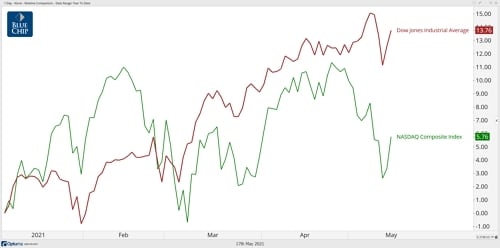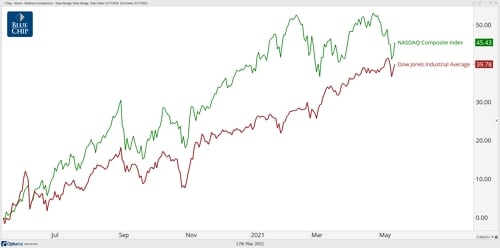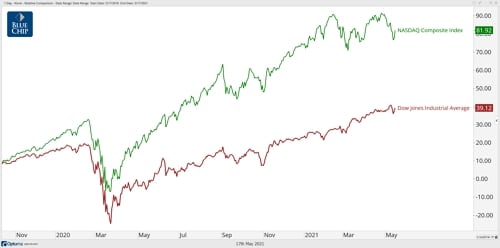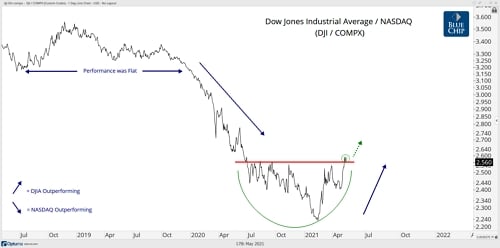Who’s playing catch-up?
At first blush, an investor could be forgiven for thinking the NASDAQ’s year-to-date relative underperformance to the Dow Jones Industrial Average signals value. After all, the Dow (representing a diversified collection of 30 large-cap Blue Chip companies) has provided YTD returns that are nearly three times that of its growth-oriented counterpart, the NASDAQ. However, prior to jumping to conclusions, we must remind ourselves that relative underperformance does not necessarily translate to an attractive valuation.

Using the price-to-earnings ratio (“P/E”), NASDAQ 100 stocks trade nearly 30x their forward 12 months earnings (according to The Wall Street Journal). While growth stocks can demand a higher P/E multiple in a depressed interest rate environment, few would argue this segment of the marketplace is looking cheap today. For reference, the Dow Jones Industrial Average is trading just north of 20x estimated earnings.
So, should investors buy the NASDAQ now, hoping to extract value as performance catches up, or could there be more damage to growth stocks ahead?
When In Doubt, Zoom Out

Let’s zoom out. As you can see, the narrative of unlocking value in the NASDAQ begins to lose steam when looking back twelve months. Even with its YTD stumble, the NASDAQ Composite outperformed the DJIA by five percentage points over this period. This makes sense since a plurality of the companies represented by the NASDAQ are technology-focused and benefitted from the “stay at home” effect of COVID-19.

Adjusting our lens even further back, the performance gap of the two indices is even more pronounced. As you can see on this three-year chart, the divergence in performance did not present itself in any meaningful way prior to the Pandemic.
As beneficiaries of the lockdown environment in 2020, many companies in the NASDAQ satisfied the equivalent of multiple years’ worth of demand for products and services in a matter of months. As a result, these companies have a tall order to fill as investors will expect continued signs of expansion in the quarters to come. Further, given the fact that growth-oriented equities derive a significant portion of their value from more distant future cash flows, any continued elevation in real interest rates may give investors pause before putting capital to work at multiples which are prone to contraction.
Weight of The Evidence
Let’s face it, NASDAQ stocks have had a tremendous run. Can it continue? Sure, anything can happen, but we would argue against the NASDAQ offering any compelling value on a shorter-term timeframe. In fact, we expect the Dow to continue to close the performance gap on the NASDAQ as interest rates rise and inflation ticks upward. As we’ve highlighted in the past, rate increases and inflation will likely be a headwind for growth-oriented companies.

As you can see above, the Dow has recently broken out of a ten-month base. Relative to NASDAQ, we expect the path of least resistance for the Dow Jones Industrial Average to be higher. We favor the Dow as long as this relationship trades above the key technical level of 2.56.
Expressions of opinion are as of this date and are subject to change without notice. The information provided does not constitute tax, legal, accounting, or other professional advice and is without warranty as to the accuracy or completeness of the information. Any information provided is not a complete summary or statement of all available data necessary for making an investment decision and does not constitute a recommendation to buy, hold or sell any security. The information has been obtained from sources considered to be reliable, but we do not guarantee that the foregoing material is accurate or complete. There are limitations associated with the use of any method of securities analysis. Indices are included for informational purposes only; investors cannot invest directly in any index. Every investor’s situation is unique, and you should consider your investment goals, risk tolerance and time horizon before making any investment. Prior to making an investment decision, please consult with your financial advisor about your individual situation. Past performance does not guarantee future results. Investing involves risk and you may incur a profit or loss regardless of strategy selected. There is no guarantee that any statements, opinions or forecasts provided herein will prove to be correct.